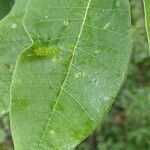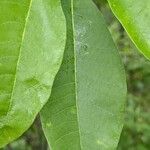A medium sized tree. It grows 15-30 m tall and spreads 4.5 m wide. The trunk is 90 cm wide. The stems are erect and the crown is dome shaped. The leaves are oval shiny dark green above and downy underneath. They are 25 cm long and 5-10 cm wide. They have teeth along the edge. The flowers are greenish white. They are produced in clusters in the axils of the leaves. There are many male flowers in heads and female flowers occur singly. The fruit are a deep red. They are berry-like and 2.5 cm long. The stone has 10 wing-like ridges.




